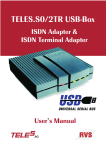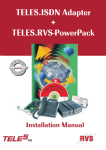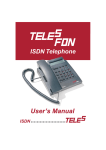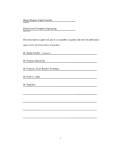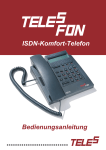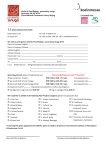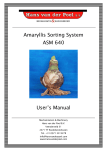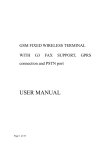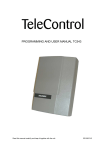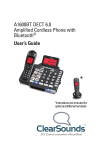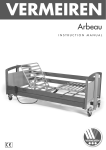Download Features
Transcript
TELES.iTA/2TR Box ISDN Terminal Adapter for Analog Devices User’s Manual TELES.iTA/2TR Box Version 1.30 User's Manual BERLIN The hardware and software described in this publication is protected by international copyright law. Use of the software is intended solely for the legitimate owner of a copy thereof after having registered with TELES AG. Unauthorized distribution or use may result in civil and criminal penalties and will be prosecuted. All rights reserved by TELES AG. The information in this publication has been compiled with great attention to detail. Nonetheless, inaccuracies and typographical errors cannot be entirely avoided. For this reason, TELES provides this information “as is”, without warranty of any kind, either expressed or implied. The information and products described herein are subject to change without notice. © 1998 by TELES AG, Berlin TELES.iTA/2TR Box Table of Contents 1 FEATURES.........................................................................................................................1 2 PACKAGE CONTENTS ...................................................................................................2 3 INSTALLING THE TELES.ITA/2TR BOX ...................................................................3 3.1 ATTACHING TELES.ITA/2TR BOX .............................................................................4 3.1.1 Attaching Power Supply .........................................................................................4 3.1.2 Attaching Analog Devices ......................................................................................4 3.1.3 Attaching to ISDN ..................................................................................................4 3.2 REQUIRED SETTINGS FOR OPERATING TELES.ITA/2TR BOX ..................................5 3.2.1 Configuring the PIN................................................................................................5 3.2.2 Assigning Call Numbers to TR Ports......................................................................6 3.2.3 Setting Service Indicator for Outgoing Calls..........................................................7 3.2.4 Changing Gain of TR Port Signals .........................................................................8 3.2.5 Set Device ID ..........................................................................................................9 4 5 USING THE TELES.ITA/2TR BOX..............................................................................10 4.1 EXTERNAL CALLS .......................................................................................................10 4.2 INTERNAL CALLS ........................................................................................................10 4.3 DISCONNECT................................................................................................................10 4.4 SENDING COMMANDS TO THE PBX ............................................................................10 4.5 HOLD AND ALTERNATE...............................................................................................11 4.6 THREE-PARTY CONFERENCE .....................................................................................12 4.7 CALL TRANSFER .........................................................................................................13 4.8 COMFORTABLE CALL TRANSFER ...............................................................................14 CONFIGURING TELES.ITA/2TR BOX FUNCTIONS..............................................15 5.1 CALL FORWARDING ....................................................................................................15 5.1.1 Setting Call Forwarding with Source and Destination..........................................15 5.1.2 Setting Call Forwarding with Destination only ....................................................16 5.1.3 Deactivating Call Forwarding...............................................................................16 5.1.4 Reactivating Call Forwarding ...............................................................................16 5.1.5 Call Forwarding Examples....................................................................................17 5.2 PERSONAL CALLBACK SERVER..................................................................................18 5.2.1 Activating Personal CallBack Server....................................................................18 5.2.2 Access Number for Personal CallBack Server......................................................19 5.2.3 CallBack Code and CallBack Number..................................................................19 5.2.3.1 Setting ...............................................................................................................19 5.2.3.2 Deleting.............................................................................................................20 © 1998 by TELES AG Berlin, Version 1.30/iTA-eu/f/8.02 Issue: June 1998 Page i TELES.iTA/2TR Box 5.2.4 5.2.5 5.2.6 Deleting Personal CallBack Destination Numbers............................................... 20 Changing Callback Number for existing CallBack Code..................................... 20 Making a Personal CallBack Call......................................................................... 21 5.3 REMOTE ADMINISTRATION ........................................................................................ 22 5.4 LED DISPLAYS ........................................................................................................... 23 5.5 SUMMARY OF TELES.ITA/2TR BOX FUNCTIONS .................................................... 24 5.6 PC INTEGRATION USING TELES.ONLINEPOWERPACK........................................... 26 5.6.1 TELES.ISDN Device Manager ............................................................................ 27 5.6.2 Software Settings.................................................................................................. 27 5.6.3 Statistics................................................................................................................ 29 6 APPENDIX....................................................................................................................... 30 6.1 TECHNICAL DATA ....................................................................................................... 30 6.2 R KEY (RELEASE KEY) ............................................................................................... 30 6.3 TROUBLESHOOTING ................................................................................................... 31 6.4 CUSTOMER SUPPORT .................................................................................................. 32 6.5 USER CONTRACT ........................................................................................................ 33 6.6 GLOSSARY ................................................................................................................... 34 6.7 INDEX .......................................................................................................................... 36 Page ii © 1998 by TELES AG Berlin, Version 1.30/iTA-eu/f/8.02,Issue: June 1998 Features The TELES.iTA/2TR Box The TELES intelligent Terminal Adapter TELES.iTA/2TR Box is an external unit that allows you to easily connect two analog terminal devices, such as conventional telephones or fax machines, to ISDN. Two standard analog TR ports (Tip&Ring) are provided for these devices on the one hand and a basic rate interface (BRI) for the ISDN line on the other. 1 Features The TELES.iTA/2TR Box does more than simply provide an ISDN interface for analog devices. Several useful features are also provided: ❑ The simultaneous operation of two analog terminal devices that support touch-tone dialing. ❑ The ability to attach all such terminal equipment (telephones, facsimile machines, an- ❑ ❑ ❑ ❑ The box supports the ISDN protocol DSS1 and is therefore suited for Euro-ISDN ports. Operation and active connections shown by LEDs. The ability to configure a call number for each TR port. All functions are set by an attached telephone that supports touch-tone dialing – but much easier via PC when attached to a PC with a TELES.ISDN board and TELES.OnlinePowerPack (see following page and section 5.6, page 26). Convenient dial support, Call Line Identification as well as iTA status display on your PC are further features offered. Internal calls between both TR ports as well as call holding and call transfer using the telephone’s R key to switch calls between both TR ports. Calls to and from ISDN phones on the same ISDN line. The ability to attach several TELES.iTA/2TR Boxes to a single ISDN line. Comfortable call transfer to other terminal devices attached to the ISDN line. Remote call forwarding. PIN protection for all important functions. Personal CallBack Server for making automatic collect calls. This is an ideal solution for situations in which you would like your telephone to be billed for calls made by family members, relatives, colleagues or even yourself when traveling. swering machines, PBX equipment etc.) ❑ ❑ ❑ ❑ ❑ ❑ Note: Due to technical differences in ISDN lines of various countries not all features of your TELES.iTA/2TR Box may be available. © 1998 by TELES AG Berlin, Version 1.30/iTA-eu/f/8.02 Issue: June 1998 Page 1 Package Contents 2 Package Contents Your TELES.iTA/2TR package is delivered with the following components: ❑ TELES.iTA/2TR Box ❑ ❑ 12 Volt external power supply Cable with RJ-45 plugs for the ISDN line ❑ Cable with RJ-11 plugs for analog devices ❑ User’s manual TELES.iTA/2TR Box Page 2 © 1998 by TELES AG Berlin, Version 1.30/iTA-eu/f/8.02,Issue: June 1998 Installing the TELES.iTA/2TR Box 3 Installing the TELES.iTA/2TR Box This chapter describes how to attach and configure your TELES.iTA/2TR Box. In order to successfully complete the installation; please follow the steps below: 1. Attach the external power supply’s power cord to the power jack of your TELES.iTA/2TR Box, and then plug the external power supply into an electric outlet. 2. Attach analog terminal devices to the TR ports at the back of the TELES.iTA/2TR Box. 3. Attach your TELES.iTA/2TR Box to the ISDN line via the ISDN jack. Following steps are optional: 4. Change your PIN. 5. Set call numbers for the TR ports. You should now be able to make and receive calls with devices attached to the TR ports. Yellow LED for internal activities Green Status LED for port 2 Red Power LED Green Status LED for port 1 ab1 TR Ports (RJ-11) to attach analog devices ab2 ISDN ISDN jack (RJ-45) to attach ISDN line © 1998 by TELES AG Berlin, Version 1.30/iTA-eu/f/8.02 Issue: June 1998 + - 12V= Power jack (RJ-45) for 12V power supply Page 3 Installing the TELES.iTA/2TR Box 3.1 Attaching TELES.iTA/2TR Box 3.1.1 Attaching Power Supply First, attach the external power supply to your TELES.iTA/2TR Box by plugging the power cable into the power jack. Plug the power supply into an electric power outlet. The TELES.iTA/2TR Box then conducts a diagnostic self-test. During the test each LED will light up and the red power LED will remain lit. 3.1.2 Attaching Analog Devices Attach your terminal equipment to the TR ports located at the back of the TELES.iTA/2TR Box. In the table below you will find a list of possible connections. Device Connector Type of Connection Devices with RJ-11 plugs (international standard) Devices with other plugs Attach your devices directly to the TR ports. (see figure on page 3) Purchase an adapter from your local dealer that converts your plug to a RJ-11. The figure on the right shows the RJ-11 plug. The letters A and B indicate the pins that are used. Lift the receiver and check if the LED for that port lights up. You can attach a maximum of three terminal devices to each TR port. 3.1.3 Attaching to ISDN Attach your TELES.iTA/2TR Box to the ISDN line (also known as the BRI or S/T interface) using the RJ-45 cable provided. To activate the ISDN line, lift the receiver of a telephone attached to the TELES.iTA/2TR Box. The appropriate green port LED should light up and a dial tone should be heard. If not, there is a problem with the ISDN line or the ISDN cable is possibly defective (see chapter 6.3). Page 4 © 1998 by TELES AG Berlin, Version 1.30/iTA-eu/f/8.02,Issue: June 1998 Installing the TELES.iTA/2TR Box 3.2 Required Settings for Operating TELES.iTA/2TR Box The TELES.iTA/2TR Box is set via a DTMF/“touch-tone” telephone (DTMF = Dual Tone Multi Frequency) attached to any port of the box. The telephone should also have a key (tone) and a # key (pound/flash). Please refer to documentation that came with your telephone to determine if your telephone is set to touch-tone dialing. If it isn’t, you should be able to switch it from dial pulsing to touch-tone dialing. All settings are made by entering a command sequence beginning with the key followed by a command number. Depending on the function desired, you then again enter the key followed by one or more numbers. Each number entered must be preceded by the key. The # key finishes the command sequence. command no. number 1 number 2 number 3 # If a setting was carried out successfully, you will hear a long beep. If a setting was unsuccessful, or if you made a mistake, you will hear a trill. Besides using a telephone for configuration, you can also make settings using a user-friendly Windows software. All you need is an ISDN board for your PC – e.g. a TELES.BRI board with the TELES.OnlinePowerPack application suite. This board should be attached to the same ISDN line as the TELES.iTA/2TR Box (see section 5.6, page 26). To configure your TELES.iTA/2TR Box, you must first configure your PIN (Personal Identification Number). 3.2.1 Configuring the PIN Several important settings for your TELES.iTA/2TR Box require you to enter a PIN (Personal Identification Number). The PIN must be a 5-digit number; PIN 00000 is configured by default. You can only perform one setting using the default PIN and that is configuring the PIN to another number. NOTE: It is imperative that you remember your newly configured PIN. We recommend writing it down and storing it in a safe place. Should you forget your PIN, you will be unable to change any settings! In this case you have to send your TELES.iTA/2TR Box back to TELES for maintenance! To change your PIN, enter the following command sequence: 90oldPINnew PINnew PIN# Example: To change the PIN from the default setting (PIN=00000) to 01234: 90000000123401234# © 1998 by TELES AG Berlin, Version 1.30/iTA-eu/f/8.02 Issue: June 1998 Page 5 Installing the TELES.iTA/2TR Box 3.2.2 Assigning Call Numbers to TR Ports The TR ports are not pre-set to any call numbers. Consequently, your TELES.iTA/2TR Box will answer all incoming calls at both ports. If you assign a unique call number to each TR port, the attached device will only answer calls sent to that number. You will find the call numbers available for your ISDN line in the documents provided by your ISDN carrier. For point-to-multipoint lines, you may receive three or more MSNs (depending on country and carrier). These MSNs (= Multiple Subscriber Numbers) are your complete call numbers without prefixes). NOTE: You must enter a call number separately at and for each TR port. To assign a call number to a TR port, proceed as follows: 1. Attach an analog telephone to the TR port (jack) you would like to configure. 2. Enter the command sequence for the call number without area code. 01PINCall number# Example: The TR port attached to your telephone is to be assigned the call number: (415) 335561. Do not enter area code. The PIN is 01234. You would enter: 0101234335561# The number will be active immediately and your telephone will now answer all calls to this number. When you make calls, this is also the number that will be transmitted to the party you’re calling. NOTE: Page 6 If you do not assign a call number to any telephone, both ports will accept all incoming calls. If only one port does not have a call number, it will not ring (even when the other device on the other port has a number and is called). Only internal calls to this port are possible in that case. If you do not assign any call numbers including a number for Personal CallBack, you will not be able to take advantage of the Personal CallBack feature, nor will you be able to perform remote administration. © 1998 by TELES AG Berlin, Version 1.30/iTA-eu/f/8.02,Issue: June 1998 Installing the TELES.iTA/2TR Box 3.2.3 Setting Service Indicator for Outgoing Calls The TELES.iTA/2TR Box and thus all terminal devices attached to it accept calls for all analog service indicators. Outgoing calls use the service indicator ‘telephony analog’. Thus it should be possible to establish connections to most usual terminal devices. Problems can arise for some fax machines attached to PBXs when they accept only calls that have the fax group 3 service indicator. In this case, you can adapt the service indicator of the fax machine’s port. Type 1 2 3 4 5 6 Function in DSS1 ISDN telephony Analog telephony Fax Group 2 Fax Group 3 Telephony option 1 Telephony option 2 Enter the following command sequence: 04PINtype# Example: To set ‘fax group 3’ (type 4) for the current port, enter: 04012344# NOTE: The service indicators ‘Telephony option 1 and 2’ are intended for PBXs that do not accept ‘Analog call’ or ‘ISDN Telephony’. © 1998 by TELES AG Berlin, Version 1.30/iTA-eu/f/8.02 Issue: June 1998 Page 7 Installing the TELES.iTA/2TR Box 3.2.4 Changing Gain of TR Port Signals Command 09 allows you to change the signal gain of the individual TR ports. It has the effect of increasing or decreasing the volume of what you hear in the telephone. Two settings are available: Number Setting Description 1 low -3,5 dB – signal is quiet 2 high +2,5 dB – signal is loud To change signal gain, enter the following command sequence: 09Number# The setting takes effect only for the TR port at which the setting is initiated. Example: To make the telephone you are using louder, enter the command sequence: 09 2# Page 8 © 1998 by TELES AG Berlin, Version 1.30/iTA-eu/f/8.02,Issue: June 1998 Installing the TELES.iTA/2TR Box 3.2.5 Set Device ID Device IDs are only necessary when you operate several TELES devices together on a common ISDN line and want to use the special functions that the TELES.Family patent offers: comfortable call transfer, programming and telephoning through TELES.OnlinePowerPack. When you’ve attached only one device – that is only your TELES.iTA/2TR Box – on the ISDN line and do not use these features then the device ID is without meaning. Changes on your part are not necessary then. The device ID is a single digit number. Numbers 1 to 8 are available. The factory settings give each device the ID 1. To change the device ID, enter the following command sequence: 92 PIN ID# Example: You would like to assign the device ID 2 to the TELES.iTA/2TR Box. 92 01234 2# For comfortable call transfer to TELES-ISDN devices on the same ISDN line, the box’s device ID always connects to port 1. For port 2, enter the number of the device ID plus 1. Example: Say the box’s device ID is set on 5. For port 1 you would simply dial 5, for port 2 dial 6 (i.e. 5+1=6). You do not have to set the additional device ID yourself, but only keep it reserved and not assign it to another device. © 1998 by TELES AG Berlin, Version 1.30/iTA-eu/f/8.02 Issue: June 1998 Page 9 Using the TELES.iTA/2TR Box 4 Using the TELES.iTA/2TR Box 4.1 External Calls Unlike when using other private branch exchanges, you will hear the dial tone for an outside line as soon as you pick up the receiver. You do not have to dial for outside access. If both B channels are busy, or if the connection between the TELES.iTA/2TR Box and the ISDN line is interrupted, you will hear two short tones and a long pause. This indicates that for the time being you can only make internal calls. 4.2 Internal Calls It is possible to call the other internal extension of a TELES.iTA/2TR Box from either extension. The extension number corresponds to the port number (either 1 or 2). Enter followed by the desired port number: port number Example: You are calling from a device attached to port 1 and would like to call the telephone on port 2. You simply enter: 2 4.3 Disconnect Some telephones are equipped with a so-called disconnect key. TELES.iTA/2TR Box emulates this function when a two key command sequence is used. Just enter: ## 4.4 Sending Commands to the PBX This function is only necessary, if your TELES.iTA/2TR Box is attached (subordinate) to a PBX. Lift the receiver and press the # key. The commands entered then go straight to your PBX; nothing is valid for the TELES.iTA/2TR Box. Page 10 © 1998 by TELES AG Berlin, Version 1.30/iTA-eu/f/8.02,Issue: June 1998 Using the TELES.iTA/2TR Box 4.5 Hold and Alternate You are conversing with one party and would like to briefly ask a third party a question, i.e. hold for enquiry. You can put the first party on hold by pressing the R key. You will then hear the dial tone and can now call the third party. After completing the call to the third party, you switch back to the first party by pressing the R key again. Switch back and forth between both parties, i.e. hold and alternate, by pressing the R key. R key third party number Example: You already have a party on the line and would like to consult someone at the number 444444. You would then enter the following: R key 444444 You can terminate a call to either party by pressing the # key twice. If one party is internal, the other parties will be connected with each other when you hang up. If both parties are external, you will terminate both connections when you hang up. However, should you be calling through a PBX, both external parties will be transferred to each other. NOTE: If difficulties arise when using the R key, check the flash time settings as described in section 6.2, page 30. © 1998 by TELES AG Berlin, Version 1.30/iTA-eu/f/8.02 Issue: June 1998 Page 11 Using the TELES.iTA/2TR Box 4.6 Three-Party Conference A three-party conference is the simultaneous connection among three parties. Besides the telephone connected to the TELES.iTA/2TR Connection between A and B. C shall be involved in a conference. Box, the other two parties have to be external callers. A three-party conference with two internal and one external party is not possible. A receives dial tone after R-key is pressed and contacts C. R Ph. C During this conference call all three participants can talk to and hear each other. When you enter the key combination # a connection on hold is linked to the existing connection to compete the conference. The conference ends when any one of the participants disconnects either by pressing ## or by hanging up. A presses *# to enable conference. * # Conference between A, B and C existis till one of the parties ends the connection. Note: The service feature three-party conference has to be supported by your ISDN carrier. Page 12 © 1998 by TELES AG Berlin, Version 1.30/iTA-eu/f/8.02,Issue: June 1998 Using the TELES.iTA/2TR Box 4.7 Call Transfer You can transfer a current conversation to a third party, by pressing the R key, calling the third party and then hanging up once that party answers. The TELES.iTA/2TR Box can A Connection between A and B B also wants to call C A presses R key, hears the dial tone and calls C. B is on hold until transferred only transfer calls from an internal party to an external party and vise-versa. Call transfers from an external party to another external party are not possible. An exception exists when the TELES.iTA/2TR Box is attached to a PBX that will handle the call transfer between external parties. C answers the call. A terminates the call with C B is then transferred to C © 1998 by TELES AG Berlin, Version 1.30/iTA-eu/f/8.02 Issue: June 1998 Page 13 Using the TELES.iTA/2TR Box 4.8 Comfortable Call Transfer You can transfer a call internally to another party on the ISDN line or interface only if it also is an ISDN device, e.g. TELES.FON or another TELES box (see “Set Device ID,” page 9). A External connection between A and B B also wants to call C A and C are on the same ISDN line. A presses ** and the device ID of C. B is on hold until transferred. To transfer calls to internal ports on the TELES.BRI/2TR Box or to external numbers, e.g. public phone numbers see “Call Transfer,” page 13. C answers the call. To transfer to another device on the same ISDN line dial: device ID A hangs up. In case there is no answer at the device to which the call should be transferred, you can retrieved it by dialing: B is then connected to C # In case the device ID does not exist on the ISDN line then the transfer will be returned automatically. Page 14 © 1998 by TELES AG Berlin, Version 1.30/iTA-eu/f/8.02,Issue: June 1998 Configuring TELES.iTA/2TR Box Functions 5 Configuring TELES.iTA/2TR Box Functions Aside from the standard configurations, the TELES.iTA/2TR Box offers the following special functions: ❑ ❑ Call Forwarding Personal CallBack 5.1 Call Forwarding If a device is temporarily not available, you can forward the call to another number. The TELES.iTA/2TR Box supports unconditional call forwarding. All incoming calls will be routed immediately to the new device. The device originally called will not ring. Call forwarding can be activated in the following ways: ❑ By entering the source number and the destination number, i.e., the number to which ❑ By entering only the destination number. In this case, the source number is the call number of the device from which the call forwarding function is activated (command 07). By making the other TR port of your TELES.iTA/2TR Box the destination call number. calls will be forwarded (command 06). ❑ The call forwarding function can be activated or deactivated at any time (command 08). 5.1.1 Setting Call Forwarding with Source and Destination Determine which TR port of the TELES.iTA/2TR Box should forward calls to which destination number. To set call forwarding, enter the following command sequence: 06PINSource numberDestination number# The source number should be the number that you assigned to the device using the command sequence: 01 PIN Call number#. Example: All calls to the number 33220 are to be forwarded to the destination number 33221. Your PIN is 01234. You would enter: 06012343322033221# To disable the function, enter the command sequence without a destination number. Example: Call forwarding for the call number 33220 is to be disabled. Your PIN is 01234. You would enter: 060123433220# © 1998 by TELES AG Berlin, Version 1.30/iTA-eu/f/8.02 Issue: June 1998 Page 15 Configuring TELES.iTA/2TR Box Functions 5.1.2 Setting Call Forwarding with Destination only Using this method, you set call forwarding without entering the source number. Calls will be forwarded from the port at which you are activating the function. This function is not available, of course for remote administration. Enter the command sequence: 07 destination number# Example: All incoming calls are to be forwarded to the destination number 33221. You would enter: 0733221# To forward a call to a device on the other TR port, you enter its port number: 07 TR port number # Example: Your telephone is attached to port 1 and you would like to forward all calls to the port 2. You would enter: 072# 5.1.3 Deactivating Call Forwarding You can temporarily deactivate the currently active call forwarding function (command 07) by entering the command sequence: 080# 5.1.4 Reactivating Call Forwarding To reactivate call forwarding (command 07), you would enter: 081# NOTE: Page 16 This will only work if call forwarding was previously set and deactivated. © 1998 by TELES AG Berlin, Version 1.30/iTA-eu/f/8.02,Issue: June 1998 Configuring TELES.iTA/2TR Box Functions 5.1.5 Call Forwarding Examples In the following examples, telephones marked A and B are attached to TR ports 1 and 2 respectively. The TELES.iTA/2TR Box can forward incoming calls from a public telephone. A calls B A An incoming call from a public phone can be forwarded to another public phone. B B forwards to A It is not possible to call a phone (B) that is set to forward back to your phone (A). A forwards to B A B B forwards to A TELES.iTA/2TR Box forwards incoming external calls only to two destination call numbers. Incoming call from public phone A forwards to B A Incoming call from public phone B forwards to C B C Public Phone Net. Calls can only be forwarded to second number when the second number is an external number. © 1998 by TELES AG Berlin, Version 1.30/iTA-eu/f/8.02 Issue: June 1998 Page 17 Configuring TELES.iTA/2TR Box Functions 5.2 Personal CallBack Server The TELES.iTA/2TR Box offers an optimal Personal CallBack Server for making automatic collect calls. This is an ideal solution for situations in which you would like to have your telephone billed for calls made by family members, relatives, colleagues or even yourself when traveling. The caller first calls the access number of the TELES.iTA/2TR Box. After entering a code identifying the caller to the TELES.iTA/2TR Box, the caller will be called back at a preconfigured call number. Please note that the caller can only be called back at this number. The caller is then granted an outside line by the TELES.iTA/2TR Box. If the TELES.iTA/2TR Box is attached to a PBX, the caller may have to dial for outside line access. As soon as the caller hears a dial tone, he can make a call. At the end of the conversation, he will, after waiting a few seconds, be given another outside line. The caller does not have to keep calling back the Personal CallBack Server in order to make additional calls. All calls made by callers through the TELES.iTA/2TR Box to further parties will be charged to the TELES.iTA/2TR Box site. The caller only pays for the initial call to the access number. 5.2.1 Activating Personal CallBack Server In order for the Personal CallBack Server to function, two B channels, i.e., both ports must be available. If one is busy, the TELES.iTA/2TR Box will not answer any calls. The following parameters must be configured for the Personal CallBack Server: ❑ The access number for the Personal CallBack Server (command 02), ❑ Up to five CallBack codes (CB codes) and numbers for return calls (commands 81, 82, 83, 84 and 85) Further functions of the Personal CallBack Server: ❑ The Personal CallBack Server access is barred, all numbers configured are deleted (command 89), ❑ The CallBack number of the Personal CallBack Server can be changed for the respective CallBack ID (command 87). ❑ CallBack is activated (command 99), Page 18 © 1998 by TELES AG Berlin, Version 1.30/iTA-eu/f/8.02,Issue: June 1998 Configuring TELES.iTA/2TR Box Functions 5.2.2 Access Number for Personal CallBack Server The access number is the telephone number you call when you want to use the Personal CallBack Server. Furthermore, this is the number to call if you want to configure the TELES.iTA/2TR Box remotely. For this reason, no other device is allowed to have this number! To configure the access number, enter the command sequence: 02PINCall number# Example: You want to configure the access number for the Personal CallBack Server to: 33445567. Do not enter a local area code! Assuming your PIN is 01234, you would enter: 020123433 44 55 67# 5.2.3 CallBack Code and CallBack Number A CallBack number is assigned to each CB code. The caller identifies himself by entering the CB code and is called back at the assigned CallBack number. The CB code has to contain five digits. The code ‘00000’ is not permitted. The caller answers the call and can use an outside line granted by the TELES.iTA/2TR Box. The charges for the call will be billed to the TELES.iTA/2TR Box and not to the caller. 5.2.3.1 Setting To set the five CB codes and the respective CallBack numbers, enter the command sequences listed below. Be sure that each CB code is used only once. 81PINCB code 1 CallBack number 1# 82PINCB code 2 CallBack number 2# 83PINCB code 3 CallBack number 3# 84PINCB code 4 CallBack number 4# 85PINCB code 5 CallBack number 5# Example: The first CB code should be set to 98765. The TELES.iTA/2TR Box should call back the number 030 22222. You would enter: 810123498765030 222222# © 1998 by TELES AG Berlin, Version 1.30/iTA-eu/f/8.02 Issue: June 1998 Page 19 Configuring TELES.iTA/2TR Box Functions 5.2.3.2 Deleting To delete just a single CB number, enter a command sequence containing only the CB code without CallBack number. 8xPINCB code x # Example: You wish to erase the third CB number. You would enter: 830123498765# To delete a CB code and number, enter a command sequence containing only the CB ID without CallBack code and number. 8xPIN # Example: You wish to erase the third CallBack. You would enter: 8301234# 5.2.4 Deleting Personal CallBack Destination Numbers All CB codes and CallBack numbers can be deleted by entering a command sequence. The Personal CallBack Server is then disabled and can no longer be used. To delete all CB codes and their respective CallBack numbers, enter the command sequence listed below: 89PINPIN# Example: You wish to erase all the CB codes and CallBack numbers. Assuming your PIN is 01234, you would enter: 890123401234# 5.2.5 Changing Callback Number for existing CallBack Code In case a caller needs to make a call from a different telephone, he or she can change the CallBack number from any telephone. This feature is intended for callers who call from various different locations. In order to change the CallBack number you must know its CB code. To change the number, enter the following command sequence: 87CB CodeCallBack number# Example: Your code is 98765 and you want to change the CallBack number to 030 222233. You would enter: 8798765030 222233# NOTE: Page 20 You can only change a CallBack number for a code that was previously configured. © 1998 by TELES AG Berlin, Version 1.30/iTA-eu/f/8.02,Issue: June 1998 Configuring TELES.iTA/2TR Box Functions 5.2.6 Making a Personal CallBack Call This function activates the Personal CallBack Server so that it calls the number assigned to the CB codes. To have the Personal Call Back Server return your call, enter: 99CB Code# Example: The following numbers have been set using the setting commands (see sections 5.2.2 and 5.2.3): the access number for the TELES.iTA/2TR Box Personal CallBack Server is 33445567, your CB code is set to 98765 and the telephone number of the device from which you are calling is 030 222222. 1. Call the CallBack Server by dialing 33445567. 2. The CallBack Server sends a dial tone. 3. Initiate the return call by entering the code 99 98765#. 4. Listen for confirmation tone and then hang up. 5. The Personal CallBack Server will then return your call by calling 030 222222. After answering the call, you will hear the dial tone of the public line available to you. You may dial the desired number now. In case the TELES.iTA/2TR Box is part of a PBX, you may have to dial for outside access. If you would like to make several calls using the Personal CallBack Server, do not hang up after finishing your first call. Simply press the # keys to terminate the call. You will remain connected to the Personal CallBack Server; you will hear the dial tone shortly thereafter so that you can make the next call. During a Personal CallBack connection, you cannot use any devices attached to the TELES.iTA/2TR Box. If someone picks up the receiver of the phone attached to port one, all three parties will hear a signal, and the person on port 1 will be connected to the caller. The party called will be put on hold until the party on port 1 hangs up. © 1998 by TELES AG Berlin, Version 1.30/iTA-eu/f/8.02 Issue: June 1998 Page 21 Configuring TELES.iTA/2TR Box Functions 5.3 Remote Administration All the functions in column 4 marked by an ‘X’ in the “Summary of TELES.iTA/2TR Box Functions” on page 24 can be configured remotely via a telephone. To take advantage of this feature, call the access number for the Personal CallBack Server and then enter the command sequence of the function you would like to change. If you have not yet configured an access number, please refer to section 5.2.2 page 19. If you would like to configure several functions, wait at least 4 seconds between commands. You will hear a dial tone indicating that the TELES.iTA/2TR Box is ready for the next command sequence. Page 22 © 1998 by TELES AG Berlin, Version 1.30/iTA-eu/f/8.02,Issue: June 1998 Configuring TELES.iTA/2TR Box Functions 5.4 LED Displays There are four LEDs on the front of the TELES.iTA/2TR Box (see “Attaching TELES.iTA/2TR Box,” page 3): LED Color Display Function Indicates Power red on Power Supply is active Internal activity yellow on TELES.iTA/2TR Box is active Port 1 or Port 2 green off Device is inactive The TELES.iTA/2TR Box is properly attached to a power source. Both B channels are busy due to internal activities (Call forwarding, Personal CallBack Server) The device on the ISDN line is inactive. The telephone's receiver is, for example, off-hook. Calls to this port will be forwarded. blinks briefly Call forwarding is activated blinks B channel is busy on Establishing connection There is a connection on the B channel. Receiver is off-hook, but there is no connection. © 1998 by TELES AG Berlin, Version 1.30/iTA-eu/f/8.02 Issue: June 1998 Page 23 Configuring TELES.iTA/2TR Box Functions 5.5 Summary of TELES.iTA/2TR Box Functions On the following page, you will find a table containing all available TELES.iTA/2TR Box functions. The table is divided into 8 columns. The columns have the following meaning: Column Heading Contents 1 An X indicates that the function applies only to a single TR port. To configure both ports, you must perform the configuration for each port separately. Name of the function. Key combination you must enter to set the function. This can only be carried out on a touch-tone telephone. All command sequences begin with and end with #. An example command sequence is shown. All examples use the PIN (Personal Identification Number) 01234 Short description of the function and the example. Factory settings for the TELES.iTA/2TR Box. An X indicates that the function can be configured directly at a device attached to the TELES.iTA/2TR Box. An X indicates that the function in this column can be configured by an external device (remote administration). For details see section 5.3. Function Command sequence Example Explanation 2 3 4 Page 24 © 1998 by TELES AG Berlin, Version 1.30/iTA-eu/f/8.02,Issue: June 1998 1 Function Call numbers for the TR ports X Call forwarding off/on Call forwarding to destination number X X Access number for Personal CallBack Call forwarding setting X Changing gain of TR port signals Setting CB codes and CallBack numbers Changing CallBack numbers Command sequence Example *89*01234*01234# *90*00000*0123*01 234# *92*01234*2# Explanation If you want to operate several TELES.iTA/2TR Boxes on a single ISDN line, you must assign each box a unique device ID. In the example, the device ID is set to the ID 2. Calls CallBack number assigned to CB code. The caller is granted a line. In the example, when the caller enters the CB code, he will be called back at the number: 030 223361. The TELES.iTA/2TR Box emulates a telephone's disconnect key. The line is disconnected without having to hang up. After you call Personal CallBack, you terminate the connection using this command. You can then make another call then. *01*PIN*number# *01*01234*335561# Sets the call numbers for the TR ports. If a number is not configured, the port will answer all incoming calls. The call number is now set to 335561. *02*PIN*number# *02*01234*335562# Sets the access number for the Personal CallBack Server and for remote administration. The access is now set to 335562. *06*PIN*source no.* *06*01234*335561* Forwards a call from the source number to the destination destination no.# 030 223360# number. If no destination number is entered, call forwarding is disabled. The source number must be the number of a device attached to the TELES.iTA/2TR Box. *07*destination no.# *07*0302233# Forwards calls from the current number to the destination number. Instead of entering an external number, you can enter the alternate TR port number. Calls are now forwarded to 030 2233 *08*0|1# *08*0# Deactivates or activates call forwarding which was set by the command sequences 06 and 07. In the example, call forwarding is deactivated. *09*1|2# *09*3# Changes the TR port signal gain. The higher the digit, the louder the volume. The port is now set to the loudest setting. *81|82|83|84|85* PIN *81*01234*98765*0 Sets the CB code and the CallBack number. You can set up to [*CB code*number]# 30 223360# 5 codes. In the example, the CB code is set to 98765 and the CallBack number 030/223360. *87*CB code*new *87*98765*030 Changes the CallBack number assigned to a particular CB no.# 223361# code. The number is changed to new no. In the example, the new CallBack no. 030/22 33 61 is assigned to the CB code 98765. Deletes all CallBack numbers and CB codes In the example, your PIN is being change from 00000 to 01234. *89*PIN*PIN# *90*oldPIN*newPIN *newPIN # *92*PIN*digit# 335562*99*98765# Deleting CallBack no. Changing your PIN Device ID (1 - 8) *99*CB code# ## Callback Disconnect Disconnect for Personal *# CallBack No number 2 X X 3 4 2 Off No number X X X X X X X No numbers X X No number Off Empty X X X X X X 00000 1 No default possible X Configuring TELES.iTA/2TR Box Functions 5.6 PC Integration using TELES.OnlinePowerPack ISDN opens new dimensions for integrating telephony with computers. PC supported telephony is also quite simple with your TELES.iTA/2TR Box. All that you need is an ISDN board for your PC – e.g. a TELES.BRI board that also comes with appropriate software. The only prerequisite is that you attach this board to the same ISDN line as your TELES.iTA/2TR Box. PC with TELES.ISDN adapter & TELES.OnlinePowerPack TELES.Online PowerPack analog telephone RJ-11 cable RJ-45 cable RJ-11 cable ISDN line socket (NT) RJ-45 cable TELES.iTA/2TR Box G3 fax By using the TELES.OnlinePowerPack all-in-one ISDN/Multimedia applications suite included with the ISDN board, you can take full advantage of ISDN: • The MCC program handles the dialing. • The integrated answering machine records incoming messages. You can pick up a call in progress or call back later from the callback list (as of version 6.0). • The ISDN device manager from TELES.OnlinePowerPack eases programming of many TELES.iTA/2TR Box functions: you can program and manage almost all functions more comfortably by using the PC rather than the telephone. • Furthermore, the ISDN device manager offers comprehensive statistics. It registers incoming and outgoing calls for any individual port and records charge units of outgoing connections. This is possible, thanks to a concept developed by TELES – the TELES.Family concept. It unites TELES terminal devices to complete, PC integrated communication systems for the office and the home. Each device attached to your ISDN line will have to be assigned a unique device ID (see “Set Device ID,” page 9). TELES.BRI boards and TELES.OnlinePowerPack are available in computer stores or directly from TELES. Page 26 © 1998 by TELES AG Berlin, Version 1.30/iTA-eu/f/8.02, Issue: June 1998 Configuring TELES.iTA/2TR Box Functions 5.6.1 TELES.ISDN Device Manager After you start the program, you will see the following window. In the Devices list box, you will see all the devices attached along with their device IDs, firmware versions and serial numbers. 5.6.2 Software Settings Select the TELES.iTA/2TR Box displayed from the list box by clicking it with the mouse. Click on the Change device setting button and you will then be prompted to enter the PIN. NOTE: If your PIN still has the factory setting (00000), you will receive a message reminding you that you cannot make any configurations with this PIN. Set the PIN using an attached telephone and proceed with the software configuration. After you have entered the PIN, your TELES.iTA/2TR Box will in turn transfer its data to the configuration program, and a dialog box containing three sheets: General, Call Forwarding and Personal CallBack will appear. © 1998 by TELES AG Berlin, Version 1.30/iTA-eu/f/8.02, Issue: June 1998 Page 27 Configuring TELES.iTA/2TR Box Functions On the General sheet, you can set the call number, the service indicator, and the signal gain for each port as well as the D channel protocol . On the Call Forwarding sheet, you can enter the call forwarding destination numbers for each port. You enable call forwarding by clicking on the active check boxes. When you check the internal (Port) option the call forwarding is to the other port and you must enter the port number as the destination number. For Personal CallBack Server, you will see an additional sheet in which you can enter the access number. You will then be able to enter individual CB codes and CallBack numbers. as pictured on the left. Page 28 © 1998 by TELES AG Berlin, Version 1.30/iTA-eu/f/8.02, Issue: June 1998 Configuring TELES.iTA/2TR Box Functions 5.6.3 Statistics The TELES.ISDN Device Manager not only allows you to easily configure your TELES.iTA/2TR Box, but also displays statistics. The statistics can only be accessed through the software. A counter for all incoming and outbound calls is maintained for each port. Additionally, the software displays the total charges for all outbound calls. The same information is displayed for all calls through the Personal CallBack Server. A click on the Clear call counters button deletes the counters for incoming and outbound calls, i.e., sets them to 0. Similarly, a click on the Clear charge counters button will reset all displayed charges. © 1998 by TELES AG Berlin, Version 1.30/iTA-eu/f/8.02, Issue: June 1998 Page 29 Appendix 6 Appendix 6.1 Technical Data Technical data of TELES.iTA/2TR Box External power supply 12 Volt, 9 Watts Interference suppression complies to CE0188X Dimensions LWH [in mm] 133x143x38 D channel protocol DSS1 in point-to-multipoint lines. Max. no. of devices on each TR port 3 6.2 R key If your analog telephone is equipped with an R key, it will not function properly if it is set to ground. Pressing the key would terminate the current connection. The recommend setting for the R key is a flash time of 90 ms. For details on how to make this setting, please refer to your telephone’s manual. Page 30 © 1998 by TELES AG Berlin, Version 1.30/iTA-eu/f/8.02, Issue: June 1998 Appendix 6.3 Troubleshooting In case you do not hear a dial tone on your terminal device (i.e. telephone), you can help isolate the problem by going through the following steps: Does the status LED light up as soon as you lift the receiver? Yes No Your telephone is properly attached. But do check the cable to the ISDN line. Check that the RJ-11 cable is securely plugged into the TELES.iTA/2TR Box and the telephone. When you lift the receiver, you do not hear a dial tone. Cause A Personal CallBack connection or Call forwarding is in progress. The yellow LED is lit. Solution Wait until the connection has been terminated and try again. Telephone does not ring for incoming calls; outgoing calls are possible though. Cause You’ve entered the incorrect number for your own number. Solution Reenter the number found in the documents you received from your local telephone company. © 1998 by TELES AG Berlin, Version 1.30/iTA-eu/f/8.02, Issue: June 1998 Page 31 Appendix 6.4 Customer Support International Help Desk Phone*) TELES Ireland Ltd. +353 (61) 716 716 Unit 3, Distribution Centre, Shannon Airport Free Zone, Co. Clare E-Mail Support: E-Mail Sales: IRELAND World Wide Web: [email protected] [email protected] http://www.teles.ie Local Help Desks TELES AG Phone*) Dovestrasse 2–4 0190/871101 (3.63 DM/min Germany only) 10587 Berlin GERMANY Fax: World Wide Web: +49 (30) 399 28 01 http://www.teles.de TELES Benelux BV De Lasso 70 NL-2371 GZ Roelofarendsveen THE NETHERLANDS Phone*) Fax: World Wide Web: 0900 2027777 (105 cpm) +31 (71) 331 7174 http://www.teles.nl TELES Italia SRL Via die Platani 6 I-20020 Arese (MI) ITALY Phone*) Fax: World Wide Web: +39 (02) 93777 100 +39 (02) 93777 101 http://www.telesitalia.it *) Available Monday through Friday from 8.30 a.m. to 6 p.m. Return Material Authorization (RMA) Should it become necessary to return the product to TELES AG for any reason, please contact the international support line to obtain a Return Material Authorization Number (RMA). Returned items will only be accepted if a RMA has been visibly placed on the outside of the return package. The product must be returned in suitable packing materials. § 6 Return of Goods The return of goods shall be accepted only if the package clearly shows a Return Material Authorization Number (“RMA Number”). Seller issues the RMA Number on Buyer’s written request, after a careful examination of the right to return material. Returned products have to be properly packed. Page 32 © 1998 by TELES AG Berlin, Version 1.30/iTA-eu/f/8.02, Issue: June 1998 Appendix 6.5 User Contract The TELES.iTA/2TR Box contains computer programs that are protected by copyright law. Illegal use of these programs may result in civil and criminal penalties. The accompanying user manual and the hardware supplied with the program are also protected by copyright law. As sole owner of these products, TELES reserves all proprietary rights of use. Warranty / Liability 1. The Seller gives the Buyer the guarantee to remedy a defect of the TELES.iTA/2TR Box within 6 years after delivery or, if this is impossible, make a substitution free of charge. This warranty is terminated if the Buyer or any third party has modified or attempted to repair the hardware or software. The liability of the Seller does not cover damages due to natural wear and tear, improper handling or operating errors 2. The Buyer shall inform the Seller in writing within 14 days of acquisition about apparent defects and return the faulty merchandise to the Seller. 3. Software defects can be repaired only if they can be reproduced. The Seller shall remedy only such software defects that substantially affect the promised use. 4. If the repairs or substitutions mentioned above in section 1 are not carried out or are impossible, the Buyer is entitled, at his option, to rescission or abatement. 5. The foregoing paragraphs are the sole and exclusive provisions regarding the warranty. They do not preclude, however, quality guarantees that protect the Buyer against risk of consequential damages. 6. In no event shall the Seller be liable for consequential damages unless resulting from malicious faults or negligence. The Seller shall not be liable for damages caused by vicarious agents. The Seller is only responsible for damages covered by the manufacturer’s liability insurance. Product liability claims regulated by the pertinent national product liability laws remain unaffected by these terms. 7. Legal venue for all obligations and liabilities arising out of this agreement shall be the head office of the Seller. © 1998 by TELES AG Berlin, Version 1.30/iTA-eu/f/8.02, Issue: June 1998 Page 33 Appendix 6.6 Glossary Term Explanation B channel Bearer Channel. An ISDN channel for data transmission allowing up to 64kbps. The Basic Rate Interface (BRI) consists of two such channels. Call forwarding A call that is directed to phone A is routed unconditionally to phone B. Every time a call is made to A, phone B rings instead. Call holding The ability to talk to a third party while still being connected to the first. The first party is said to be ‘on hold’. Call transfer You receive an incoming call and transfer it to another party. CAPI Common ISDN Application Programming Interface. The software interface between your ISDN device and PC. There are at present two versions available: CAPI 1.1 and CAPI 2.0. TELES offers two versions: Dual-CAPI 1.1 + 2.0 and CAPI (32bit for MS-Windows). CB code CallBack code. Five-digit code that must be entered in order to activate the Personal CallBack Server function. CLI Call Line Identification - a BRI board attached to the same ISDN line as the TELES.iTA/2TR Box can identify all calls made to the TELES.iTA/2TR Box. D channel ISDN channel used for call signaling. It allows data rates of up to 16kbps. D channel protocol Protocol for ISDN signaling. In Europe, the DSS1 protocol is standard. DSS1 The European standard protocol (Euro-ISDN or ETSI). You can only use terminal devices on the ISDN line that were designed for this protocol DTMF Dual Tone Multi Frequency. Also known as touch-tone dialing. Only phones capable of touch-tone dialing can be used to configure TELES.iTA/2TR Box settings and functions. ISDN Integrated Service Digital Network. The digital telephone network Jack A female socket for plugs such as the RJ-11 or the RJ-45 LED Light Emittance Diode. The 4 small “lights” on the front of the TELES.iTA/2TR Box case. LED MSN Multiple Subscriber Number. In the DSS1 protocol of Euro-ISDN, a subscriber is provided several numbers (MSNs) which he can freely assign to his terminal devices. PBX Private Branch Exchange. An internal, not public, telephone switching system. Page 34 © 1998 by TELES AG Berlin, Version 1.30/iTA-eu/f/8.02, Issue: June 1998 Appendix Term Explanation Personal CallBack Feature allowing authorized callers to be called back by a Personal CallBack Server. The caller is then granted a line on which he or she can make calls that are charged to the telephone number of the Personal CallBack Server. PIN Personal Identification Number. Special numerical code which functions as a password. Provider Someone who offers services, such as Internet access, over public telephone lines. Pulse dialing Older procedure for transmitting telephone numbers also known as rotary dialing. This procedure can only support digits and not characters like (tone) or # (flash). RJ-11 connector Plug frequently used to attach analog devices. The plug is made of clear plastic and has 4 contacts of which two are used for telephony. RJ-45 connector Plug used primarily for attaching ISDN devices. It is very similar in appearance to the RJ-11 connector but larger and has 8 contacts of which 4 are used for ISDN. S/T interface ISDN network terminator or ISDN basic rate interface. The ISDN bus is attached to it. This is the 4-wire cable to attach your ISDN devices. TA Terminal Adapter. See T/R port. T/R port Tip&Ring. It is an analog port to ISDN that allows you to attach your non-ISDN devices (telephone, modem, fax G3 etc.) to the ISDN line. This either can be an external device or integrated into the ISDN device itself. On TELES hardware the T/R ports are sometimes labeled ‘AB’ TR port US standard See T/R port. According to the US standard, the inner two wires of the RJ-11 plug are used. © 1998 by TELES AG Berlin, Version 1.30/iTA-eu/f/8.02, Issue: June 1998 Page 35 Index 6.7 Index AB 35 LED access number 19, 28 MCC 26 B channel 23, 34 MSN 6, 34 Multiple Subscriber Number 6, 34 basic rate interface 1, 34, 35 BRI call forwarding 1, 4, 34 15, 23, 25, 28, 34 Call Line Identification 34 call number 3, 6 call transfer 14 CallBack code on hold 18, 19, 21, 25, 28, 34 25, 28 CAPI 34 CB see CallBack comfortable call transfer 9, 14 D channel D channel protocol device ID 10, 18 PBX 10, 34 PC integration Personal CallBack Device Manager PIN 6 pound Private Branch Exchange protocol R key remote administration 1, 34 RJ-11 DTMF 5, 34 RJ-45 5 S/T interface external call 10 service indicator factory settings 24 signal gain fax 7 flash 5, 30 hold 11, 12 10, 34 1 11, 30 6, 19, 22, 24 4, 31, 35 35 4, 35 7, 28 8, 25, 28 29 T/R 35 TELES Patent 26 11 TELES.Family concept hold for enquiry 11 TELES.OnlinePowerPack incoming call 6 terminal device intelligent Terminal Adapter 1 three-party conference 10 5 3, 4 statistics hold and alternate internal call 5, 35 3, 25, 27, 35 9 DSS1 Dual Tone Multi Frequency, DTMF 18, 21, 28, 35 port 28 10, 25 26 6, 25 point-to-multipoint power supply 29 disconnect Personal Identification Number 34 9, 25, 27 11 outside line Personal CallBack Server number 3, 23, 31, 34 Tip&Ring 26 9, 26 3, 4, 35 12 1, 35 ISDN 1, 34 touch-tone dialing ISDN adapter 9, 26 TR port 3, 6 ISDN bus 35 volume 8, 25 ISDN line 1, 3, 4, 10, 23, 35 Page 36 1, 5, 34 © 1998 by TELES AG Berlin, Version 1.30/iTA-eu/f/8.02, Issue: June 1998









































